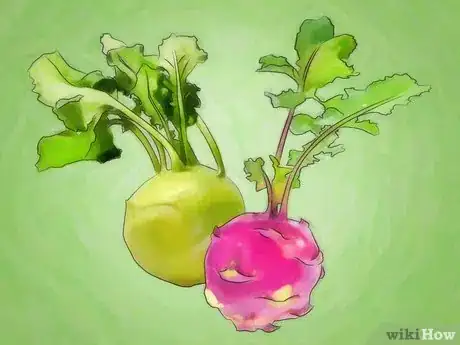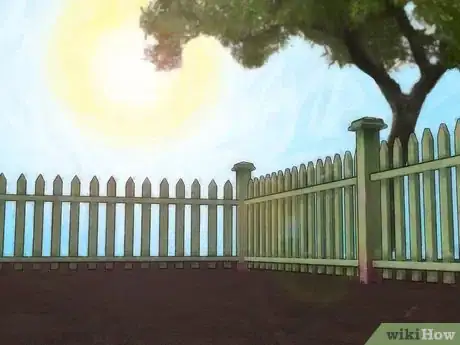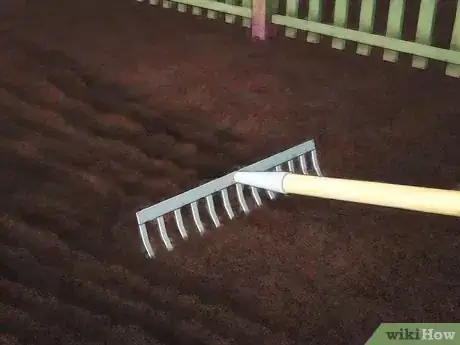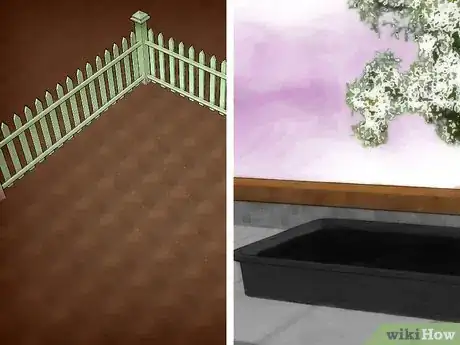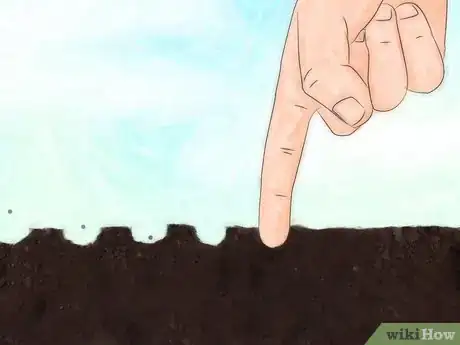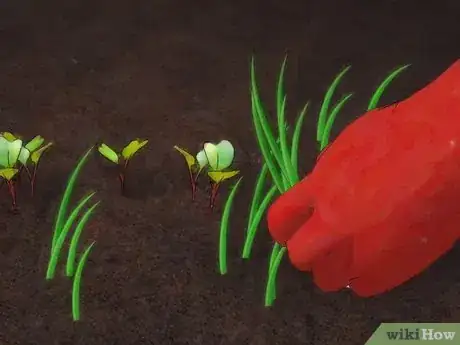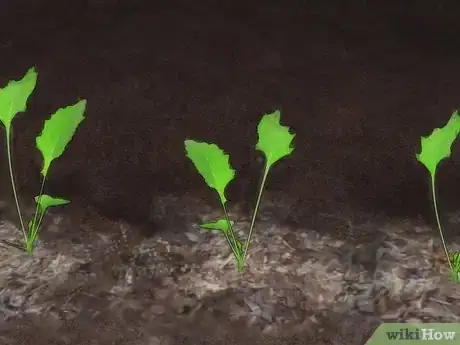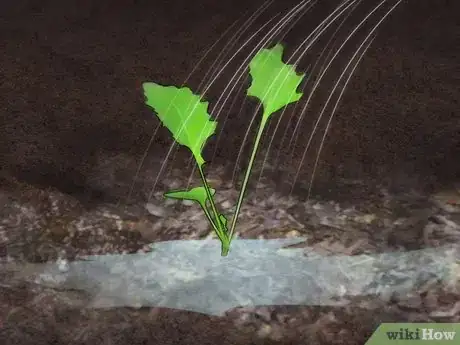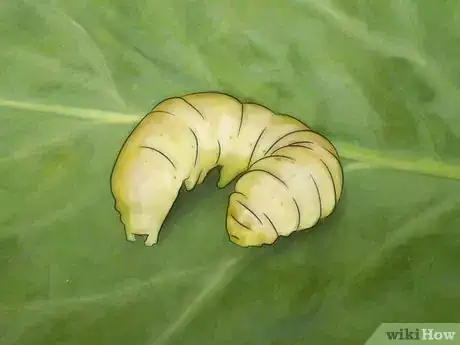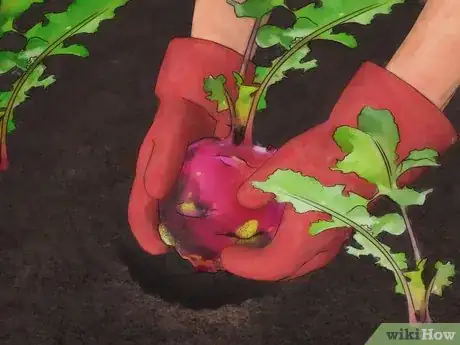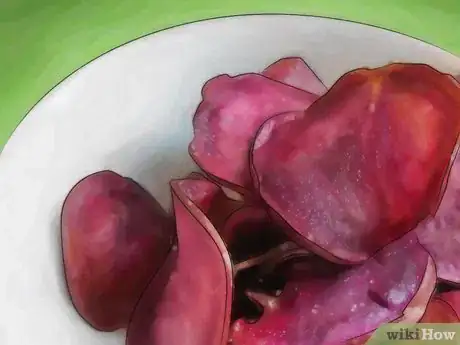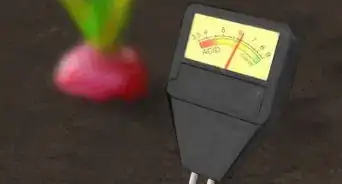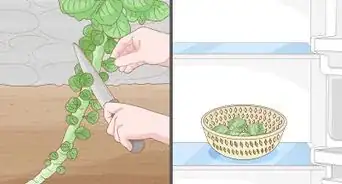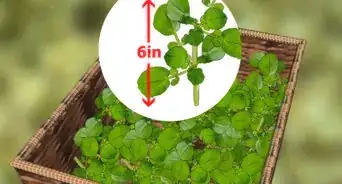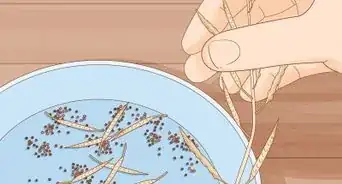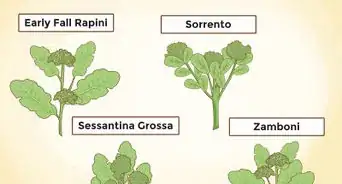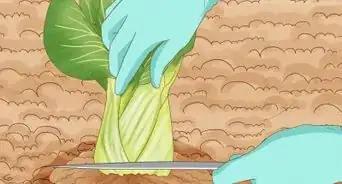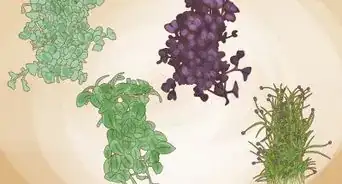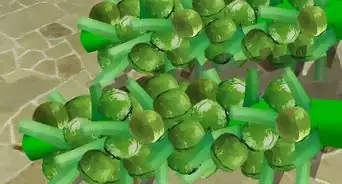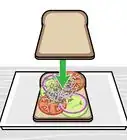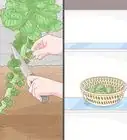This article was co-authored by Lauren Kurtz. Lauren Kurtz is a Naturalist and Horticultural Specialist. Lauren has worked for Aurora, Colorado managing the Water-Wise Garden at Aurora Municipal Center for the Water Conservation Department. She earned a BA in Environmental and Sustainability Studies from Western Michigan University in 2014.
There are 11 references cited in this article, which can be found at the bottom of the page.
wikiHow marks an article as reader-approved once it receives enough positive feedback. In this case, 100% of readers who voted found the article helpful, earning it our reader-approved status.
This article has been viewed 33,681 times.
Popular in Germany and India, the kohlrabi is named after the German words for cabbage (kohl) and turnip (rübe), and the crisp and versatile vegetable does resemble both its namesakes. This hardy biennial is often grown as an annual. It is easy to grow in mild climates, making it a unique and delicious addition to any garden. You can learn to plant and care for kohlrabi to give your crop the best possibility of success.
Steps
Planting Kohlrabi
-
1Select a variety of kohlrabi. Kohlrabi is a brassica, in the cabbage family. Increasingly popular, kohlrabi is also available in different varieties, all easy to grow, with slight variations in look and time to maturity. The biggest difference is whether or not you pick a green or purple variety.
- Green kohlrabi varieties include the Korridor and the Winner, which mature quickly, in about 50 days, compared to about 60 for some other varieties. Bright lime-green in color, they make an attractive addition to a garden bed.[1]
- Purple kohlrabi varieties like the Azur Star and Kolibri are particularly bug-resistent, because of the purple leaves on the plant, which keep the insects away.[2] Taste-wise, you won't notice much difference.
- Storage varieties like Kossak, Superschmelz, and Gigante are, as you might guess, much larger than the regular varieties of kohlrabi. They'll last longer in the cellar or the fridge, prepared correctly. Taste-wise, these varieties are all very similar.
-
2Select a planting location for kohlrabi. Kohlrabi should be planted in full sun, close to other roots, like potatoes, beets, onions. Kohlrabi are big drinkers and feeders, which means they'll need a good amount of water and fertile soil.[3] It's usually recommended that you plant five or six cabbage-family plants for each member of the household. Sow three times the amount.
- Kohlrabi should be kept in a separate part of the garden from pole beans, tomatoes, and strawberries.[4]
Advertisement -
3Prepare the soil for sowing. Several weeks before the last frost of spring, Kohlrabi may be planted, which means you can start tilling your soil early. Kohlrabi should be planted in well-tilled soil enriched with compost. It's hardy in most conditions, though it excels in soil with a pH between 5.5 and 6.8.[5]
- Good drainage is also helpful in avoiding rot and blight in your kohlrabi plants, so make sure you've got an area of the garden that doesn't collect water too much.
-
4Plant kohlrabi in cool weather. Kohlrabi is a hardy grower that should be planted about a month before the last frost in spring. Ideally, you want the plant to mature before the temperature gets much over 75 F, which means you’ll want to plant it early, among your earliest sows, probably, in an area with a very hot summer.[6] Kohlrabi will mature in 50-60 days.
- If you live in a place with warm winters, it’s also common to plant kohlrabi in late autumn to harvest in early winter. The plant should be able to withstand autumn frosts.
- If winter's running long, you can start kohlrabi in pots indoors and move the plants outside about a month before the first frost, then plant them after they have hardened.
-
5Plant seeds in an even row. Kohlrabi seeds should be sowed in moist soil about a 1⁄2 inch (1.3 cm) deep and an inch apart, a single seed in each hole. Use your finger to make a small indent in the ground, then cover the seeds loosely with soil. Leave at least an inch between each plant, which you'll thin out later.[7]
- Kohlrabi should be planted in rows, which should be spaced about a foot apart to give them room to spread out and mature.[8]
Caring for the Plants
-
1Weed carefully and regularly.[9] When you see your starts coming up, weed around them very carefully, paying special attention to milkweed, thistle, and any other local weeds. Kohlrabi are easily beaten out in the beginning, and have a shallow root structure, since the bulb is above ground. The most critical time for kohlrabi is in the first couple of weeks. Let them flourish, then thin them out.
-
2Thin successful seedlings about 5–8 inches (12.7–20.3 cm) apart. After a couple of weeks, the plants should be about 6 inches (15.2 cm) tall and you can start thinning out the most successful of them to give them room to grow. Carefully dig up the plants and re-space them, so they're about 8 inches (20.3 cm) apart, moving some to other places in the garden if necessary.[10]
- The greens of young kohlrabi can be eaten raw, in salads, or can be thrown into stir-frys as any field green. It's a unique and nutrient-rich way of spicing up a meal.
-
3Mulch plants with compost.[11] Once the plants are 4–5 inches (10–13 cm) tall, you should provide them a bit of structure and nitrogen support. Pack some compost around the base of kohlrabi to help hold them up and inject some nutrients into the soil. This can be the big difference between healthy-looking big bulbs and woody inedibles.
-
4Water deeply and frequently. Kohlrabi need lots of water, and do well in relatively mild or Mediterranean climates. If the soil is dry, under-watered kohlrabi will become woody and unpleasant to eat.[12] If the split striations on the bulb start to look dry, increase your waterings.
- When watering, water the soil around the base of each bulb, don't water on top of the plants, which can increase the possibility of rot. This goes for most cabbage.
-
5Watch closely for cutworms. Kohlrabi and other cabbages are susceptible to cutworms, making it important that you stay on top of these pests as your plants mature. You'll notice holes in the leaves and egg clusters on the underside of the leaves. If you find this, move swiftly.[13]
- Wash leaves with egg clusters on them thoroughly, removing the eggs as you find them. It’s common to “collar” the leaf stems of the kohlrabi by tying them up to get the leaves off the ground. This can help to keep the infestation at bay. You can use Bacillus thuringiensis (or Bt) if you’ve got a serious problem.[14]
- Keep an eye out for rot, as well. “Cabbage yellows” is easy to recognize, due to the yellowish-brownish color the leaves will take on. Remove infected plants entirely.
-
6Harvest kohlrabi by pulling up the entire plant. Kohlrabi is usually ready to be harvested after about 45-60 days.[15] The stem should be about 2–3 inches (5.1–7.6 cm) in diameter, and the bulbs will be big and healthy-looking. The bulbs of different varieties will grow to different sizes, so you'll partially be using your judgment. If you let them go too long, kohlrabi will become slightly woody and unpleasant.
- The length of time that it takes to grow depends on growing conditions and which variety you are growing.
-
7Enjoy kohlrabi raw or cooked. Kohlrabi have a crisp texture and a mild flavor that makes them a versatile and nutrient-rich food for your table. It's like a cross between a cabbage and an apple, sweet and savory at the same time. Roast it up with other root vegetables, bake and mash kohlrabi, or serve it in a mixed vegetable sauté.[16]
- Kohlrabi is eaten in Germany as a bar snack, dressed with salt, cut into slices, and served raw. It's maybe the best possible way to eat this crunchy vegetable, served with a mug of beer.
Expert Q&A
-
QuestionAfter the plant starts growing, do you trim back the leaves so the fruit can grow?
 Lauren KurtzLauren Kurtz is a Naturalist and Horticultural Specialist. Lauren has worked for Aurora, Colorado managing the Water-Wise Garden at Aurora Municipal Center for the Water Conservation Department. She earned a BA in Environmental and Sustainability Studies from Western Michigan University in 2014.
Lauren KurtzLauren Kurtz is a Naturalist and Horticultural Specialist. Lauren has worked for Aurora, Colorado managing the Water-Wise Garden at Aurora Municipal Center for the Water Conservation Department. She earned a BA in Environmental and Sustainability Studies from Western Michigan University in 2014.
Professional Gardener Trimming back the leaves is not necessary to grow kohlrabi. You can cut some young tender leaves to eat raw or cooked as you would kale or other greens.
Trimming back the leaves is not necessary to grow kohlrabi. You can cut some young tender leaves to eat raw or cooked as you would kale or other greens. -
QuestionMy kohlorabi only has big leaves, but no bulbs. What is the problem?
 Mark O'GuinCommunity AnswerMost likely it's too much fertilizer. When over-fertilized, the plant does not need to form a storage bulb for sugars and water.
Mark O'GuinCommunity AnswerMost likely it's too much fertilizer. When over-fertilized, the plant does not need to form a storage bulb for sugars and water. -
QuestionMy kohlrabi is bolting, and forming flower stems instead of the ball root. If I top the plant, will it encourage the ball to form? I live in Phoenix Arizona and it's already warm here.
 Community AnswerYou need to shade it. Place a shade cloth across the top of planting area to slow down the seeding process. This is also done with basil and lettuce, two other crops with a tendency to bolt. Once the crop is well on its way, you can use white sprinkler pipe to create an arched frame, then lay shade cloth across that. This allows filtered light through and slows the bolting process.
Community AnswerYou need to shade it. Place a shade cloth across the top of planting area to slow down the seeding process. This is also done with basil and lettuce, two other crops with a tendency to bolt. Once the crop is well on its way, you can use white sprinkler pipe to create an arched frame, then lay shade cloth across that. This allows filtered light through and slows the bolting process.
Things You'll Need
- Kohlrabi seeds
- A good humus-filled garden
- A climate suitable to kohlrabi
References
- ↑ http://vegvariety.cce.cornell.edu/main/showVarieties.php?searchCriteria=Kohlrabi&searchIn=1&crop_id=0&sortBy=overallrating&order=DESC&sideSearch=Search
- ↑ http://vegvariety.cce.cornell.edu/main/showVarieties.php?searchCriteria=Kohlrabi&searchIn=1&crop_id=0&sortBy=overallrating&order=DESC&sideSearch=Search
- ↑ https://bonnieplants.com/how-to-grow/growing-kohlrabi/
- ↑ https://www.motherearthnews.com/organic-gardening/companion-planting-guide-zmaz81mjzraw
- ↑ http://www.harvesttotable.com/2009/03/how_to_grow_kohlrabi/
- ↑ https://harvesttotable.com/how_to_grow_kohlrabi/
- ↑ https://www.seedsavers.org/site/pdf/grow-save-kohlrabi.pdf
- ↑ https://digitalcommons.usu.edu/cgi/viewcontent.cgi?referer=&httpsredir=1&article=1673&context=extension_curall
- ↑ https://extension.illinois.edu/veggies/kohlrabi.cfm
- ↑ https://harvesttotable.com/how_to_grow_kohlrabi/
- ↑ https://bonnieplants.com/how-to-grow/growing-kohlrabi/
- ↑ https://bonnieplants.com/how-to-grow/growing-kohlrabi/
- ↑ https://harvesttotable.com/how_to_grow_kohlrabi/
- ↑ https://www.motherearthnews.com/organic-gardening/how-to-grow-kohlrabi-zmaz07aszgoe
- ↑ https://harvesttotable.com/harvest-store-kohlrabi/
- ↑ https://www.thekitchn.com/5-tasty-ways-to-prepare-kohlrabi-60321
About This Article
To grow kohlrabi, plant kohlrabi seeds in a sunny outdoor spot that's near other roots, like potatoes and beets. Wait until 1 month before the last frost in spring, or plant the seeds in late autumn if you live somewhere with warm winters. When it's time to plant your kohlrabi, bury the seeds 1/2 inch deep and 1 inch apart in rows. Then, after a couple of weeks, thin the seedlings so they're about 5-8 inches apart. To help your kohlrabi grow healthy and strong, water them frequently so the soil is always moist. After 45-60 days, your plants should be ready to harvest. To learn how to treat pests on kohlrabi, scroll down!
